Saeed Afshar
University of Western Sydney
Beamformed 360° Sound Maps: U-Net-Driven Acoustic Source Segmentation and Localization
Aug 01, 2025Abstract:We introduce a U-net model for 360{\deg} acoustic source localization formulated as a spherical semantic segmentation task. Rather than regressing discrete direction-of-arrival (DoA) angles, our model segments beamformed audio maps (azimuth and elevation) into regions of active sound presence. Using delay-and-sum (DAS) beamforming on a custom 24-microphone array, we generate signals aligned with drone GPS telemetry to create binary supervision masks. A modified U-Net, trained on frequency-domain representations of these maps, learns to identify spatially distributed source regions while addressing class imbalance via the Tversky loss. Because the network operates on beamformed energy maps, the approach is inherently array-independent and can adapt to different microphone configurations without retraining from scratch. The segmentation outputs are post-processed by computing centroids over activated regions, enabling robust DoA estimates. Our dataset includes real-world open-field recordings of a DJI Air 3 drone, synchronized with 360{\deg} video and flight logs across multiple dates and locations. Experimental results show that U-net generalizes across environments, providing improved angular precision, offering a new paradigm for dense spatial audio understanding beyond traditional Sound Source Localization (SSL).
An End-to-End Approach for Child Reading Assessment in the Xhosa Language
May 23, 2025Abstract:Child literacy is a strong predictor of life outcomes at the subsequent stages of an individual's life. This points to a need for targeted interventions in vulnerable low and middle income populations to help bridge the gap between literacy levels in these regions and high income ones. In this effort, reading assessments provide an important tool to measure the effectiveness of these programs and AI can be a reliable and economical tool to support educators with this task. Developing accurate automatic reading assessment systems for child speech in low-resource languages poses significant challenges due to limited data and the unique acoustic properties of children's voices. This study focuses on Xhosa, a language spoken in South Africa, to advance child speech recognition capabilities. We present a novel dataset composed of child speech samples in Xhosa. The dataset is available upon request and contains ten words and letters, which are part of the Early Grade Reading Assessment (EGRA) system. Each recording is labeled with an online and cost-effective approach by multiple markers and a subsample is validated by an independent EGRA reviewer. This dataset is evaluated with three fine-tuned state-of-the-art end-to-end models: wav2vec 2.0, HuBERT, and Whisper. The results indicate that the performance of these models can be significantly influenced by the amount and balancing of the available training data, which is fundamental for cost-effective large dataset collection. Furthermore, our experiments indicate that the wav2vec 2.0 performance is improved by training on multiple classes at a time, even when the number of available samples is constrained.
Seeing like a Cephalopod: Colour Vision with a Monochrome Event Camera
Apr 15, 2025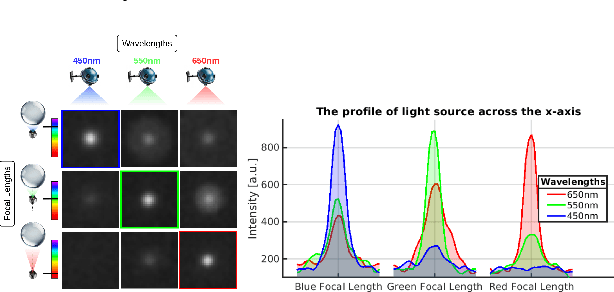
Abstract:Cephalopods exhibit unique colour discrimination capabilities despite having one type of photoreceptor, relying instead on chromatic aberration induced by their ocular optics and pupil shapes to perceive spectral information. We took inspiration from this biological mechanism to design a spectral imaging system that combines a ball lens with an event-based camera. Our approach relies on a motorised system that shifts the focal position, mirroring the adaptive lens motion in cephalopods. This approach has enabled us to achieve wavelength-dependent focusing across the visible light and near-infrared spectrum, making the event a spectral sensor. We characterise chromatic aberration effects, using both event-based and conventional frame-based sensors, validating the effectiveness of bio-inspired spectral discrimination both in simulation and in a real setup as well as assessing the spectral discrimination performance. Our proposed approach provides a robust spectral sensing capability without conventional colour filters or computational demosaicing. This approach opens new pathways toward new spectral sensing systems inspired by nature's evolutionary solutions. Code and analysis are available at: https://samiarja.github.io/neuromorphic_octopus_eye/
NeuroMorse: A Temporally Structured Dataset For Neuromorphic Computing
Feb 28, 2025Abstract:Neuromorphic engineering aims to advance computing by mimicking the brain's efficient processing, where data is encoded as asynchronous temporal events. This eliminates the need for a synchronisation clock and minimises power consumption when no data is present. However, many benchmarks for neuromorphic algorithms primarily focus on spatial features, neglecting the temporal dynamics that are inherent to most sequence-based tasks. This gap may lead to evaluations that fail to fully capture the unique strengths and characteristics of neuromorphic systems. In this paper, we present NeuroMorse, a temporally structured dataset designed for benchmarking neuromorphic learning systems. NeuroMorse converts the top 50 words in the English language into temporal Morse code spike sequences. Despite using only two input spike channels for Morse dots and dashes, complex information is encoded through temporal patterns in the data. The proposed benchmark contains feature hierarchy at multiple temporal scales that test the capacity of neuromorphic algorithms to decompose input patterns into spatial and temporal hierarchies. We demonstrate that our training set is challenging to categorise using a linear classifier and that identifying keywords in the test set is difficult using conventional methods. The NeuroMorse dataset is available at Zenodo, with our accompanying code on GitHub at https://github.com/Ben-E-Walters/NeuroMorse.
Noise Filtering Benchmark for Neuromorphic Satellites Observations
Nov 18, 2024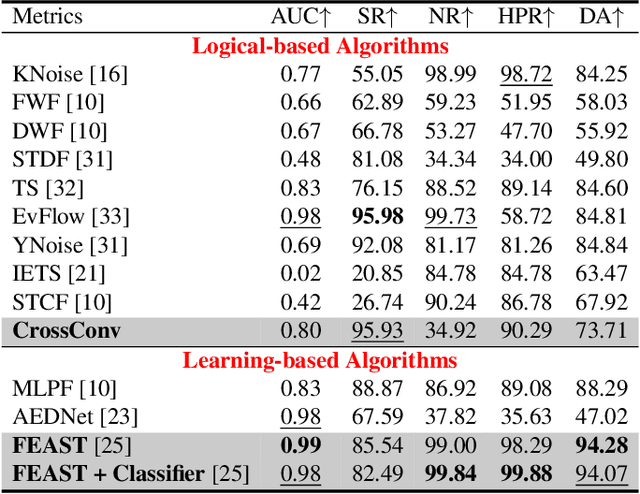
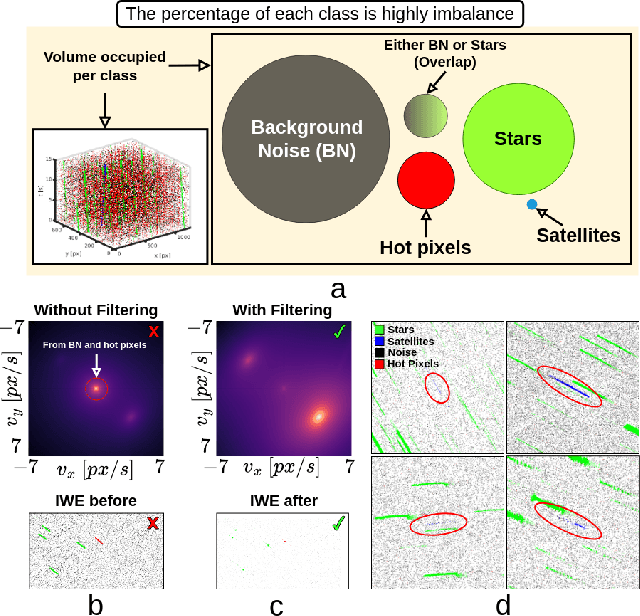
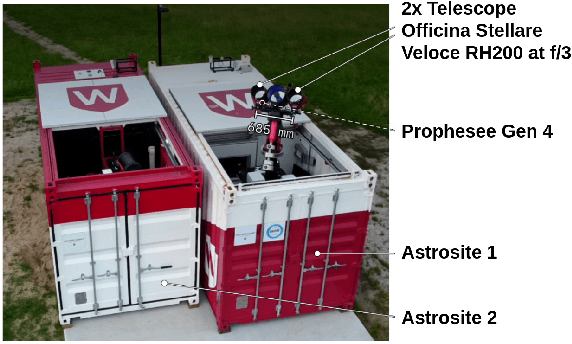
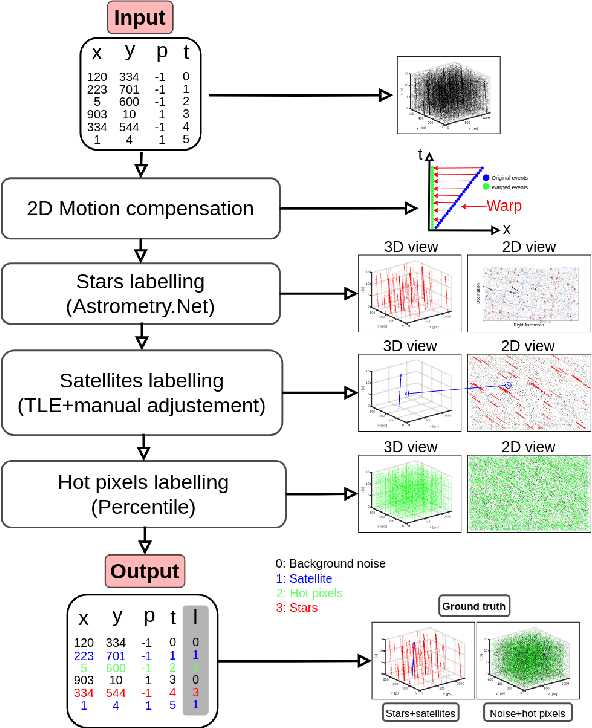
Abstract:Event cameras capture sparse, asynchronous brightness changes which offer high temporal resolution, high dynamic range, low power consumption, and sparse data output. These advantages make them ideal for Space Situational Awareness, particularly in detecting resident space objects moving within a telescope's field of view. However, the output from event cameras often includes substantial background activity noise, which is known to be more prevalent in low-light conditions. This noise can overwhelm the sparse events generated by satellite signals, making detection and tracking more challenging. Existing noise-filtering algorithms struggle in these scenarios because they are typically designed for denser scenes, where losing some signal is acceptable. This limitation hinders the application of event cameras in complex, real-world environments where signals are extremely sparse. In this paper, we propose new event-driven noise-filtering algorithms specifically designed for very sparse scenes. We categorise the algorithms into logical-based and learning-based approaches and benchmark their performance against 11 state-of-the-art noise-filtering algorithms, evaluating how effectively they remove noise and hot pixels while preserving the signal. Their performance was quantified by measuring signal retention and noise removal accuracy, with results reported using ROC curves across the parameter space. Additionally, we introduce a new high-resolution satellite dataset with ground truth from a real-world platform under various noise conditions, which we have made publicly available. Code, dataset, and trained weights are available at \url{https://github.com/samiarja/dvs_sparse_filter}.
Unsupervised Motion Segmentation for Neuromorphic Aerial Surveillance
May 24, 2024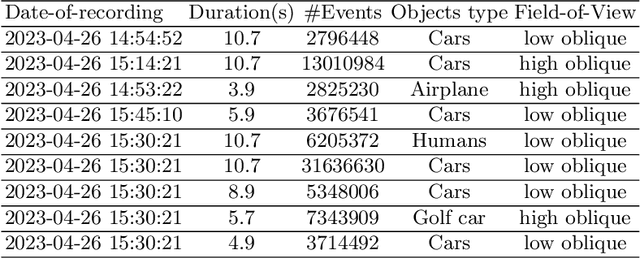
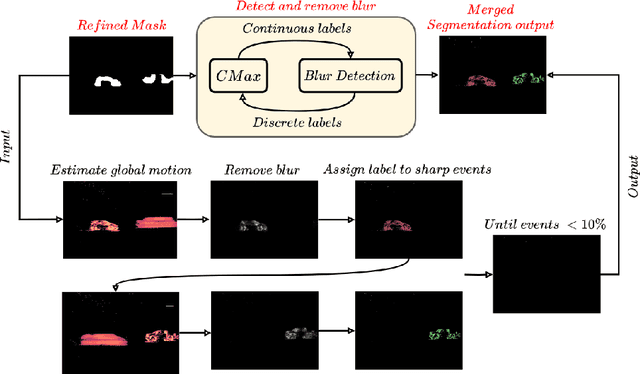
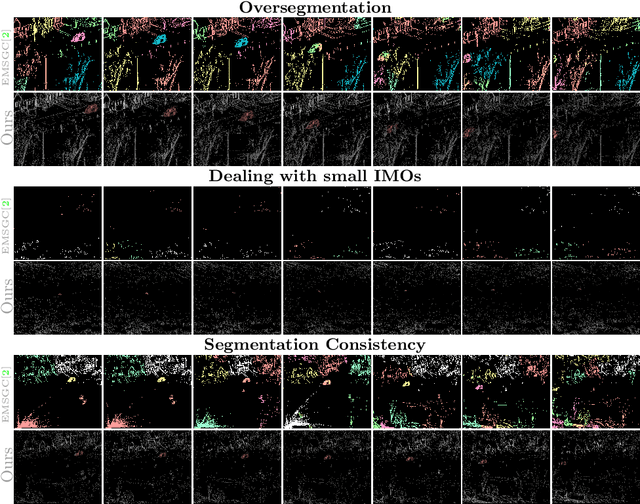
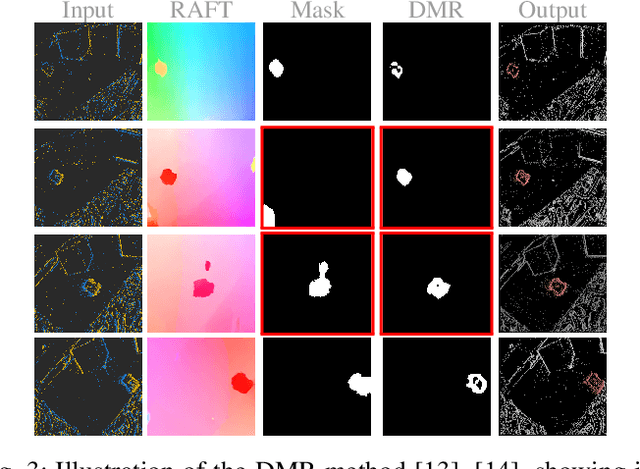
Abstract:Achieving optimal performance with frame-based vision sensors on aerial platforms poses a significant challenge due to the fundamental tradeoffs between bandwidth and latency. Event cameras, which draw inspiration from biological vision systems, present a promising alternative due to their exceptional temporal resolution, superior dynamic range, and minimal power requirements. Due to these properties, they are well-suited for processing and segmenting fast motions that require rapid reactions. However, previous methods for event-based motion segmentation encountered limitations, such as the need for per-scene parameter tuning or manual labelling to achieve satisfactory results. To overcome these issues, our proposed method leverages features from self-supervised transformers on both event data and optical flow information, eliminating the need for human annotations and reducing the parameter tuning problem. In this paper, we use an event camera with HD resolution onboard a highly dynamic aerial platform in an urban setting. We conduct extensive evaluations of our framework across multiple datasets, demonstrating state-of-the-art performance compared to existing works. Our method can effectively handle various types of motion and an arbitrary number of moving objects. Code and dataset are available at: \url{https://samiarja.github.io/evairborne/}
A Neuromorphic Architecture for Reinforcement Learning from Real-Valued Observations
Jul 06, 2023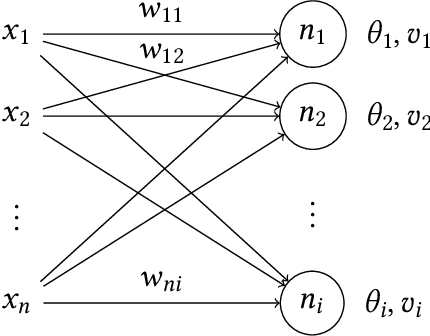
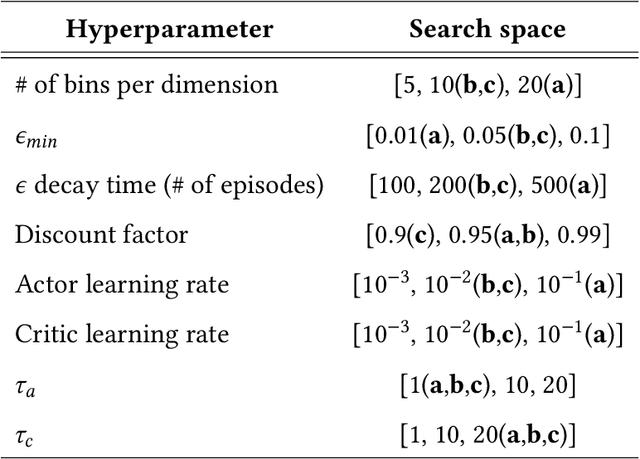
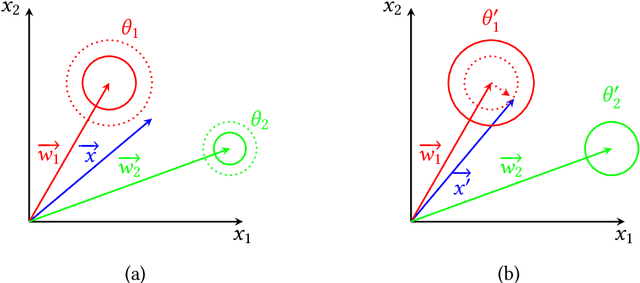
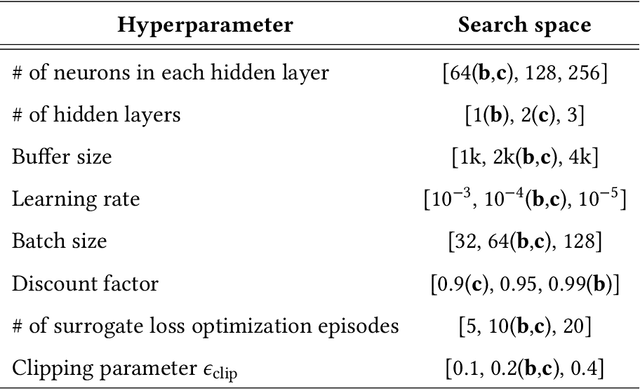
Abstract:Reinforcement Learning (RL) provides a powerful framework for decision-making in complex environments. However, implementing RL in hardware-efficient and bio-inspired ways remains a challenge. This paper presents a novel Spiking Neural Network (SNN) architecture for solving RL problems with real-valued observations. The proposed model incorporates multi-layered event-based clustering, with the addition of Temporal Difference (TD)-error modulation and eligibility traces, building upon prior work. An ablation study confirms the significant impact of these components on the proposed model's performance. A tabular actor-critic algorithm with eligibility traces and a state-of-the-art Proximal Policy Optimization (PPO) algorithm are used as benchmarks. Our network consistently outperforms the tabular approach and successfully discovers stable control policies on classic RL environments: mountain car, cart-pole, and acrobot. The proposed model offers an appealing trade-off in terms of computational and hardware implementation requirements. The model does not require an external memory buffer nor a global error gradient computation, and synaptic updates occur online, driven by local learning rules and a broadcasted TD-error signal. Thus, this work contributes to the development of more hardware-efficient RL solutions.
Efficient Implementation of a Multi-Layer Gradient-Free Online-Trainable Spiking Neural Network on FPGA
May 31, 2023Abstract:This paper presents an efficient hardware implementation of the recently proposed Optimized Deep Event-driven Spiking Neural Network Architecture (ODESA). ODESA is the first network to have end-to-end multi-layer online local supervised training without using gradients and has the combined adaptation of weights and thresholds in an efficient hierarchical structure. This research shows that the network architecture and the online training of weights and thresholds can be implemented efficiently on a large scale in hardware. The implementation consists of a multi-layer Spiking Neural Network (SNN) and individual training modules for each layer that enable online self-learning without using back-propagation. By using simple local adaptive selection thresholds, a Winner-Takes-All (WTA) constraint on each layer, and a modified weight update rule that is more amenable to hardware, the trainer module allocates neuronal resources optimally at each layer without having to pass high-precision error measurements across layers. All elements in the system, including the training module, interact using event-based binary spikes. The hardware-optimized implementation is shown to preserve the performance of the original algorithm across multiple spatial-temporal classification problems with significantly reduced hardware requirements.
Density Invariant Contrast Maximization for Neuromorphic Earth Observations
May 03, 2023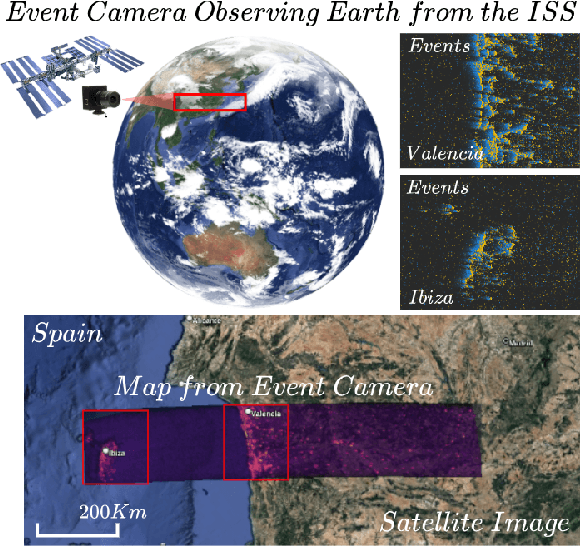
Abstract:Contrast maximization (CMax) techniques are widely used in event-based vision systems to estimate the motion parameters of the camera and generate high-contrast images. However, these techniques are noise-intolerance and suffer from the multiple extrema problem which arises when the scene contains more noisy events than structure, causing the contrast to be higher at multiple locations. This makes the task of estimating the camera motion extremely challenging, which is a problem for neuromorphic earth observation, because, without a proper estimation of the motion parameters, it is not possible to generate a map with high contrast, causing important details to be lost. Similar methods that use CMax addressed this problem by changing or augmenting the objective function to enable it to converge to the correct motion parameters. Our proposed solution overcomes the multiple extrema and noise-intolerance problems by correcting the warped event before calculating the contrast and offers the following advantages: it does not depend on the event data, it does not require a prior about the camera motion, and keeps the rest of the CMax pipeline unchanged. This is to ensure that the contrast is only high around the correct motion parameters. Our approach enables the creation of better motion-compensated maps through an analytical compensation technique using a novel dataset from the International Space Station (ISS). Code is available at \url{https://github.com/neuromorphicsystems/event_warping}
Event-driven Spectrotemporal Feature Extraction and Classification using a Silicon Cochlea Model
Dec 14, 2022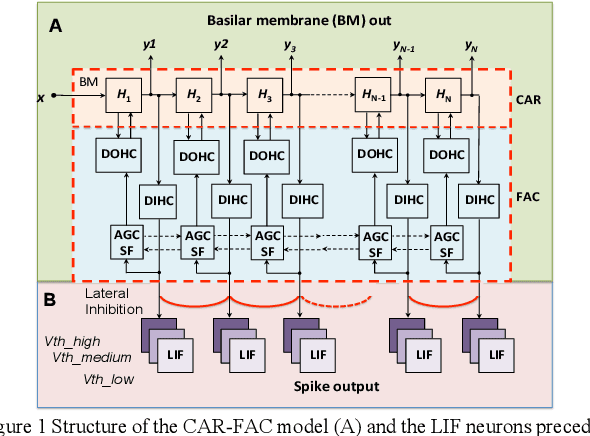
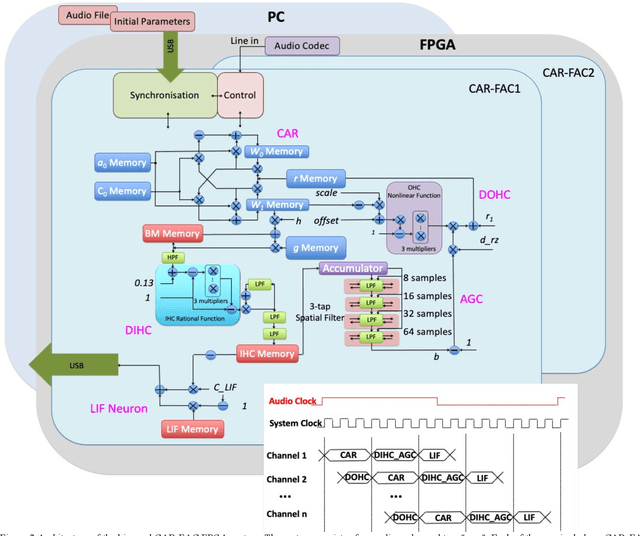
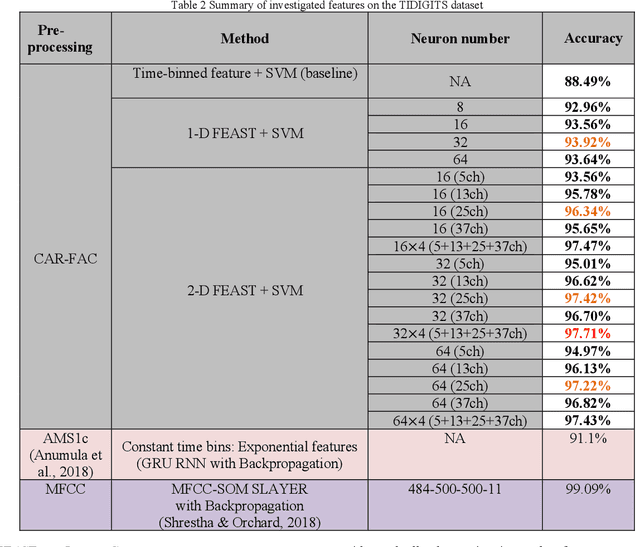
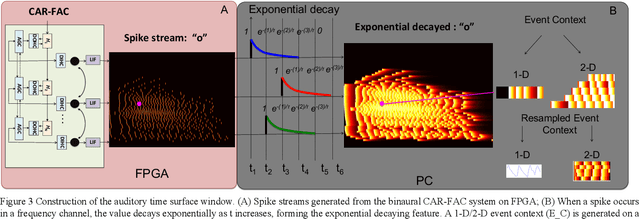
Abstract:This paper presents a reconfigurable digital implementation of an event-based binaural cochlear system on a Field Programmable Gate Array (FPGA). It consists of a pair of the Cascade of Asymmetric Resonators with Fast Acting Compression (CAR FAC) cochlea models and leaky integrate and fire (LIF) neurons. Additionally, we propose an event-driven SpectroTemporal Receptive Field (STRF) Feature Extraction using Adaptive Selection Thresholds (FEAST). It is tested on the TIDIGTIS benchmark and compared with current event-based auditory signal processing approaches and neural networks.
 Add to Chrome
Add to Chrome Add to Firefox
Add to Firefox Add to Edge
Add to Edge